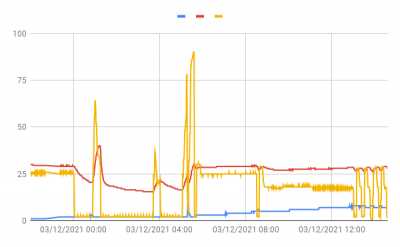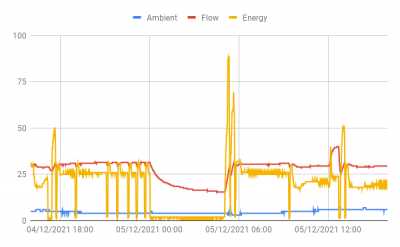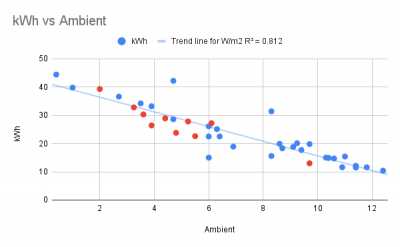Hi Kev,
As I am continually looking for ways to reduce energy consumption and improve efficiency, I had a session in the playroom with your data with the following results. Please see attached spreadsheet.
For comparability it is assumed that the ambient air temperature is constant throughout the day.
Table 1 is the results obtained with a constant indoor air temperature of 21C and outdoor air temperatures varying from 0C to 10C.
I don't think that you will be surprised to learn that your heat pump uses more energy at lower ambient air temperatures, but you may be concerned by how much. According to the data your ASHP uses 3.2 times more energy at 0C, than it does at 10C. At the same time the heat demand of your home increased by 1.9 times, which clearly shows the Achilles Heal where ASHP's are concerned.
Table 2 shows the result for an indoor air temperature of 20C, Table 3 is at 19C, and Table 4 is at 18C.
Table 5 shows the reduction of energy consumption that could be achieved by lowering the indoor air temperature from 21C to 20C. It would appear that an energy reduction of between 8.8% and 12.2% may be possible, equating to approximately 4.5kWh per day at 0C and 2kWh per day at 10C.
Table 6 shows the reduction of energy consumption that could be achieved by lowering the indoor air temperature from 21C to 19C. It would appear that an energy reduction of between 17.1% and 23.7% may be possible, equating to approximately 8.9kWh per day at 0C and 3.8kWh per day at 10C.
Table 7 shows the reduction of energy consumption that could be achieved by lowering the indoor air temperature from 21C to 18C. It would appear that an energy reduction of between 24.6% and 34.4% may be possible, equating to approximately 12.8kWh per day at 0C and 5.6kWh per day at 10C.
I didn't take the investigation lower than 18C, because 'she who must be obeyed' started to complain. ☹️
I then decided to try to investigate your idea of switching off your ASHP for 6 hours overnight. The problem with just switching off the pump is that the thermal mass of your home is an unknown, which makes calculation of the rate of reduction of the indoor temperature impossible, so I thought it better to reduce the indoor temperature in a controlled manner.
Table 8 is the results obtained by lowering the indoor air temperature from 21C to 20C for a period of 6 hours, at outdoor air temperatures varying from 0C to 10C.
Table 9 is the results obtained by lowering the indoor air temperature from 21C to 20C for a period of 2 hours and to 19C for a period of 4 hours, at outdoor air temperatures varying from 0C to 10C.
Table 10 is the results obtained by lowering the indoor air temperature from 21C to 20C for a period of 2 hours and to 19C for a period of 2 hours, and then to 18C for a period of 2 hours, at outdoor air temperatures varying from 0C to 10C.
Table 11 shows the reduction of energy consumption that could be achieved by lowering the indoor air temperature from 21C to 20C for 6 hours. It would appear that an energy reduction of between 2.2% and 3% may be possible, equating to approximately 1.1kWh per day at 0C and 0.5kWh per day at 10C.
Table 12 shows the reduction of energy consumption that could be achieved by lowering the indoor air temperature from 21C to 20C for 2 hours and to 19C for 4 hours. It would appear that an energy reduction of between 3.6% and 5% may be possible, equating to approximately 1.9kWh per day at 0C and 0.8kWh per day at 10C.
Table 13 shows the reduction of energy consumption that could be achieved by lowering the indoor air temperature from 21C to 20C for 2 hours and to 19C for 2 hours and to 18C for 2 hours. It would appear that an energy reduction of between 4.2% and 5.9% may be possible, equating to approximately 2.2kWh per day at 0C and 0.95kWh per day at 10C.
Obviously, the reduction in energy consumption is not as great as reducing the indoor temperature throughout the whole day, but the comfort level may not be as severely impacted.
I would suggest that anyone considering trying this exercise should start lowering the indoor air temperature 2 hours prior to going to bed, and commence bringing the indoor temperature back up to the desired level, 2 hours before rising in the morning. I suspect that to be able to schedule the temperature changes, will require the system to be operating in the auto adaptation mode, rather than just weather compensation.
It may be possible to make much greater reductions in energy consumption if we can find a method of pre-heating the air going into the ASHP, which is an area that I am researching at the moment, but if anyone has any ideas I would welcome their input.
Derek,
thanks, that's really interesting. As you say it's a balance between comfort and cost. I'm not surprised by the effect of dropping room temp all day but I think in my case I'm finding dropping for a few hours may have more of an effect. This is because the house take a long time to warm up from the night time low (18.5-19C) to 21 or so; more like 7 or 8 hours. So the house is cooler for a lot longer than in your model. I think my heat loss/production is quite finely balanced with the current heat curve so any cooling/heating event takes a while to recover from. I'm actually OK with that at the moment. As you say it's hard to model without knowing how the house heats up/cools down.
If I were using room thermostats and higher flow temps I think it would be different because this would keep the ASHP running until the target temp was reached. I think auto-adaptation would do this too because I think it would increase the flow temp beyond the set weather compensation value until the target temp was met. Both these methods may actually make switching off for a while use more energy. Maybe? The ASHP will have slightly less heat to produce but will be doing it in a shorter time.
I think my next experiment will be to offset the curve down 2 or 3 rather than turning the heating off. I can't time this though; it'll have to be at going to bed/waking up so 7-8 hours or so.
This is last night. Heating off a 12am, on at 5am.
The first overnight peak is HW, the second is defrost. Then the heating comes on; after the peak it's steady at first and then cycling as it warms up.
Hi Kev,
Unfortunately your graph doesn't show the indoor temperature, which makes assessing the thermal mass difficult. If you are finding that your home cools down fairly quickly, then this would suggest a low thermal mass. The other problem of course, is that the indoor temperature will fall much quicker, and to a lower value, when it is colder outside.
My final suggestion, to take the temperature down from 21C to 18C over a 3 hour period, and then bring the temperature back up over a 3 hour period, could possibly be the most beneficial, but of course would require to be scheduled, so would have to be on thermostat control or auto adaptation.
Since your thermostats are turned up at the moment to allow full weather control, you could try lowering them to say 20C, to see if your ASHP stops. I suspect that this will be the case, so it would be possible to set your thermostats at say 22C during the day, to allow full weather compensation control, and then gradually ramp them down and back up overnight, to help conserve energy.
my next monitoring equipment purchase will be some temperature monitors as recommended by @batalto. The house only loses 2-3C in 6 hours when it's close to zero. It's a bit unusual at home just now because we're having work done in the house and the doors/windows are opn more than usiual.
That's a good idea with thermostats. I'll give that a try after I try offsetting the weather comp.
I suspect I'm tinkering at the margins now I have the basics (weather comp/room temp) about right but it's quite good fun.
I've confirmed with some extra monitoring that my flow temps are being underestimated by 4-5C. At the moment, Melcloud says 31C and it's actually 33-34C. One for the suppliers and I'm on to them.
Still doing OK with switching off at night. It actually suits us; it's a bit cooler in the morning and gradually warms up through the day. lt's probably saving a little because we're OK with allowing the house to heat up gradually.
This is a graph of the last 24 hours.
You can see the heating on through late afternoon with a couple of cycles. The cycling later is after I lit the log burner; it bumped up the room temp to 24C so I assume it has some effect on the flow temps (remember I'n not on a room thermostat; it's flow temp only and I didn't change it).
Then, the usual peak to reach the flow temp in the morning, a bit of modulating down and then HW at 3pm. Interesting to see how it all works.
Hi Kev,
Thanks again for the data, always highly useful.
Looking at the results, it would appear that your idea of switching off your ASHP overnight, is indeed a good way of reducing your energy consumption, particularly when done in conjunction with weather compensation control. If auto adaptation control was used instead, you would probably find (as Justin did) that the ASHP ramps up the water flow temperature to a higher value, for longer, and hence the energy saving may not be as great.
When using auto adaptation control, it would probably be more efficient to lower and raise the indoor temperature in a gradual controlled manner, thereby keeping the water flow temperature at the absolute minimum. At the end of the day it is down to individual choice, as to how best to achieve maximum energy conservation, whilst maintaining personal levels of comfort.
Another experiment, this time with turning the heating off at night. The red dots are with the heating turned off between 12am and 5am; the blue running 24/7. The house cools 2-3C overnight and takes 2-3 hours to warm up in the morning but it's fine for us. Is it using less energy? Probably. The energy use graphs show a morning peak but then settle down.
Hi Kev,
Have you noticed an increase in defrost cycles during the present cold, damp weather?
Did you ever get your MMSP fully operational?
Not so far and no! The installer's was supposed to get back to me to arrange but never did. I have chased but nothing yet.
You might be interested in this though. The numbers are from your model and the consumption is pretty close to what I get in practice.
Kev
@kev-m how did you plot the graphs Kev? Where did the data come from?
Daikin Altherma 3H HT 12kWh ASHP with Mixergy h/w cylinder; 4kW solar PV with Solic 200 electric diverter; Honda e and Volvo EX30 Ultra Twin Performance electric vehicles with Myenergi Zappi mk1 & Ohme chargers
@kev-m you might want some axis labels. I'm assuming X is ambient temperature, left is power in kW and right is COP?
- 26 Forums
- 2,364 Topics
- 53.6 K Posts
- 210 Online
- 6,029 Members
Join Us!
Worth Watching
Latest Posts
-
RE: ASHP sizing - value of Heat Transfer Coefficient
Sorry, but I cant see what the point of this is unless ...
By JamesPa , 2 hours ago
-

RE: Octopus Cosy Heat Pump Owners & Discussion Thread
TC Thermostatic Radiator Valve TRV Plastic Decorators S...
By Toodles , 5 hours ago
-
RE: Ecodan unable to hit legionella target temp - what's the consensus?
UPDATE: Thanks everyone who commened with suggestions h...
By 9jwr9 , 10 hours ago
-
-

How long will your energy contract last?
Some heat pump tariffs don’t run as long as a heat pu...
By Toodles , 2 days ago
-

@morgan They are unsupervised these days, can’t get the...
By Toodles , 2 days ago
-
-

RE: Setback savings - fact or fiction?
Exactly. We only need to compare conditions, to decide ...
By cathodeRay , 3 days ago
-
RE: Balancing financial efficiency and comfort using the Octopus Cosy tariff
I found because I have very low heat loss I can set bac...
By RadWhisperer , 4 days ago
-
RE: Need Help Optimising My Rushed ECO4 Install: 12kW Bosch Heat Pump
Welcome @mickamills We too have an oversized 12kW Sa...
By Old_Scientist , 4 days ago
-
RE: My Powerwall 3 Consumes 3-4 kWh/Day in Self-Consumption: Is This Normal?
@caron I can confirm that the power usage of the PW3 is...
By Old_Scientist , 4 days ago
-
RE: Speedcomfort radiator fans
Thats true, but having tried (and succeeded) in constru...
By JamesPa , 4 days ago
-
RE: Solis S6-EH1P8K-L-PLUS – Why I Chose It and What I’ve Learned So Far
@bash brilliant, thanks for the feedback
By energy9165 , 4 days ago
-

RE: Heat Pump Heats the House… But It’s Not Cosy. Emitter Changes or System Tweak?
@alastair There I was, feeling grumpy, he said “Cheer u...
By Toodles , 4 days ago
-
RE: Grant Aerona: Is there a setting to keep the 2-port valve open during pump blockade
Depends on OAT. Mine cycles at OAT>10 and of course...
By JamesPa , 4 days ago
-
RE: New Fogstar 15.5kWh upright solution
@transparent My conclusion is as you have noted, tha...
By Bash , 4 days ago
-
RE: Mitsubishi Ecodan R290 10kW performance
And to you too. Wishing you a very enjoyable festive s...
By Sheriff Fatman , 4 days ago
-

RE: External pipework insulation
They do? But that isn't apparent from the photos we'r...
By Transparent , 4 days ago
-

RE: Say hello and introduce yourself
@velcro welcome to the forums. Please feel free start a...
By Mars , 5 days ago
-
Daikin EDLA11D3V3 DHW Settings
I have a newly installed EDLA11D3V3 which I'm still get...
By Velcro , 5 days ago









